Diario del diseñador – Trailer Park Boys: Dinero grasiento
Trailer Park Boys: Greasy Money es un juego inactivo inusual. El juego presenta una licencia muy específica y una jugabilidad muy poco convencional. Desafía muchas de las convenciones del género, agregando elementos como una narrativa lineal episódica, requisitos de ascensión muy rígidos y un extenso sistema gacha que está profundamente entretejido en el núcleo del juego. Sin embargo, el juego ha logrado ser un éxito comercial y de crítica, con un promedio de al menos 4,5 estrellas en cada versión y estableciendo récords de ingresos para el género de juegos inactivos. Esta es una visión privilegiada de cómo nació este diseño poco convencional, y cómo y por qué funciona.
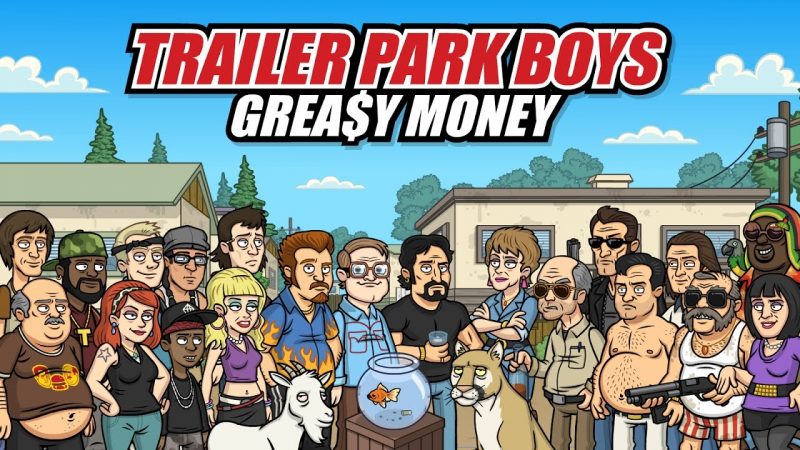
Historia del origen de Trailer Park Boys
Mi nombre es Dave Rohrl y llevo casi 25 años produciendo y diseñando juegos. Actualmente dirijo una pequeña empresa de consultoría en diseño de juegos que ayuda a estudios de juegos móviles de todo el mundo a resolver problemas de diseño desafiantes. East Side Games se acercó a mí a principios de 2016 para asesorar a algunos de sus equipos de desarrollo y ayudarlos con sus nuevos productos.
La compañía estaba desarrollando un juego inactivo basado en Trailer Park Boys. El juego cometió una serie de errores críticos de diseño. El juego contaba con tres pantallas principales, cada una con una actividad diferente, en honor a los tres personajes principales de la franquicia. Las tres pantallas eran de vital importancia para el juego. Esto hizo difícil articular y centrarse en el centro creativo del juego.
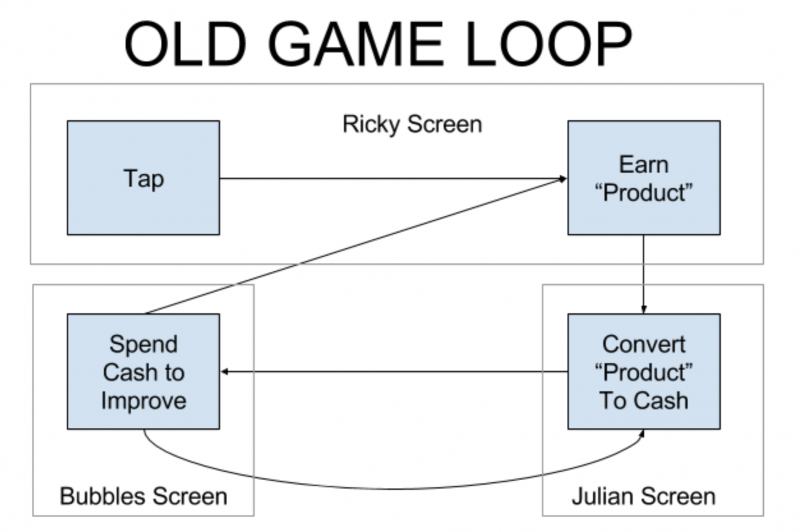
La pantalla del primer módulo requirió toques constantes para cebar la bomba de la economía. Este es un error de diseño común que cometen los recién llegados al género inactivo, quienes a menudo asumen que los juegos de clicker se tratan de... bueno... hacer clic. Como lo han demostrado numerosas investigaciones, esto no es en absoluto su núcleo. Más bien, los jugadores disfrutan dejando que el juego genere recursos pasivamente entre sesiones para poder gastar esos recursos en mejorar sus economías.
Los recién llegados al género inactivo, que a menudo asumen que los juegos de clicker se tratan de... bueno... hacer clic... esto no es en absoluto su esencia.
El segundo módulo fue extraño. Nuevamente fue necesario tocar para convertir la moneda obtenida en la primera pantalla en la principal moneda suave del juego: el dinero. Luego, el usuario navegaba a una tercera pantalla, lo que le permitía gastar dinero para actualizar las operaciones en las otras dos pantallas, posiblemente con algún elemento de automatización.
East Side me trajo para evaluar el juego. Y mis comentarios fueron rápidos, directos e inequívocos. El diseño central del juego no funcionaba y necesitaba una optimización significativa o un reinicio completo.
The team decided to restart the game using familiar core mechanics from idle games like Adventure Capitalist or Doomsday Clicker with a few enhancements supporting the IP. The player would build up businesses in the eponymous trailer park to earn money, to level up the businesses (which we referred to as acquiring customers), and occasionally fight the antagonist law enforcement officers that bedevil the boys. The existing team struggled to take the design further than this, so East Side asked me to partner with the game’s producer to lead the game’s design.
Extra Requirements
In addition to the usual requirements that come with any mobile game project, like building a fun game with good retention and monetization, the game came with some unusual requirements that we needed to accommodate in the design.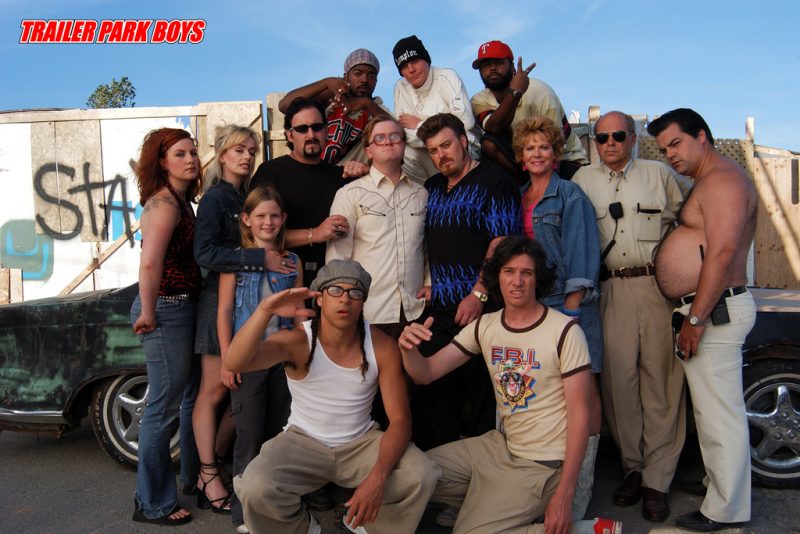
The game was, of course, based on a license. Trailer Park Boys is a faux documentary series, originally broadcast in Canada and now distributed by Netflix. It features the antics of petty felons who live in a trailer park in Nova Scotia, constantly trying to earn easy money through scams that the trailer park supervisors and local cops try to thwart. The show is a cult hit, with a small but very passionate following.
As with any licensed game, we wanted to make sure that we used the license to strongly shape not only the presentation, but also the core gameplay. We wanted the player to feel like they were running their own scams and getting their own a$$#s thrown in jail. And because the game was based on a strong character franchise, we wanted to feature the characters prominently in gameplay and to tell their stories in the show’s cheeky, hilarious tone.
In addition, the game was looking expensive on its original course, and rebooting the design certainly didn’t make it any cheaper. As a result, there was a lot of concern about the game monetizing well – particularly given that idle games are generally not high ARPDAU products. The team and East Side’s management looked around for ways to monetize the game better, and – given the fact that we were all playing quite a bit of Clash Royale at the time – it’s not too surprising that we settled in on the notion of adding a card upgrade system backed by a gacha (random reward) system to the game, supported by a secondary, non-inflationary currency – Liquor.
 Related ReadHow to Design a Gacha SystemIn MonetizationAdam Telfer
Related ReadHow to Design a Gacha SystemIn MonetizationAdam Telfer
Stories, Seasons, and Ascension
The original design for integrating stories into the game was to make short cutscenes and associate them with selected achievements, much like Adventure Capitalist associates its event rewards with reaching certain business levels.
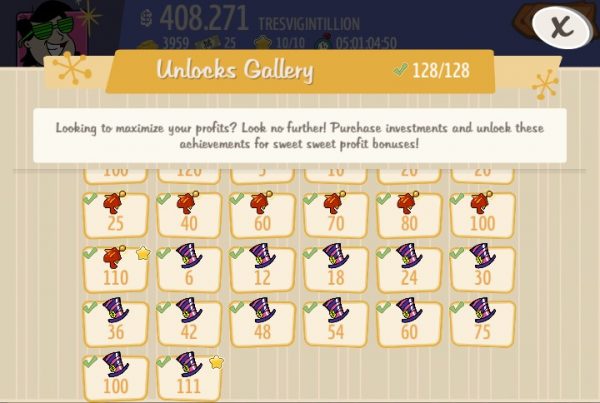
Unfortunately, I saw a number of issues with this approach. Players would enjoy lots of cutscenes early in the game, but as they became more established, cutscenes would inevitably drift further and further apart. As these rewarding plot interludes became less and less frequent, players could grow bored with the game and churn out.
We also couldn’t guarantee the sequence in which players would see cutscenes, so it would be impossible for us to tell real stories – just to offer one-off vignettes. This was a deal-breaker, as the franchise is heavily focused on episodic comedy storytelling.
Instead, I proposed a different approach to dispensing the story. We would break the game up into seasons, where each season would tell a single TPB story. Of course, the player moved from season to season by ascending.
We showed an intro scene at the beginning of each season, continuation scenes throughout based on the number of goals completed, and a finale scene just before the season’s final boss fight. This allowed us to implement a classic three act structure to build the kind of narrative arc that fans of the series love. It kept players playing for the concrete reward of seeing the next cutscene. Players got addicted to the end-of-season experience where they would experience a burst of fun activities – see a cutscene, play a boss fight, collect a bunch of rewards, and roll right into the next season’s intro cutscene and the fast early portion of the next season.
Goals

Of course, having decided to implement seasons, we needed a way to define for players to complete a season. We looked at other idle games that had implemented ascension requirements, like the cash requirements in Doomsday Clicker or the progress requirements in Tap Titans, but we found them pretty uninteresting. So we decided to lift a page from typical casual games and give the player a series of goals to complete. Once the player had complete enough of the goals we set before them, they could end the season, fight a boss, and ascend.
As soon as we added this feature to the game, the gameplay started to feel much more interesting. Rather than always buying the cheapest or highest yield business available to you, having player specific goals forces the player to focus on different aspects of the game at different times. This made the game feel more structured and gave players more opportunities to feel smart and strategic.
Our original system gave the player only one goal at a time. Although this was still fun, it led to real problems when the player was making slow progress toward their one and only goal. 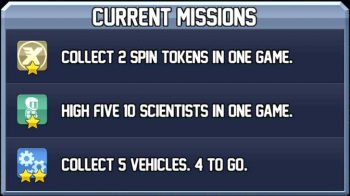 This was especially painful when the goal required some random rewards or other random elements. Jason Bailey, East Side’s Chairman, came up with the idea of having 3 goals available at all times, similar to Halfbrick’s Jetpack Joyride. After a bit of experimentation, we settled into the final structure, giving the player three tracks of goals – one linked to earning and spending soft currency, one linked to earning secondary currency and gacha items, and the third related to spending secondary currency and gacha. This led to a robust system that allowed non-payers to progress at their own pace while giving payers an obvious way to accelerate.
This was especially painful when the goal required some random rewards or other random elements. Jason Bailey, East Side’s Chairman, came up with the idea of having 3 goals available at all times, similar to Halfbrick’s Jetpack Joyride. After a bit of experimentation, we settled into the final structure, giving the player three tracks of goals – one linked to earning and spending soft currency, one linked to earning secondary currency and gacha items, and the third related to spending secondary currency and gacha. This led to a robust system that allowed non-payers to progress at their own pace while giving payers an obvious way to accelerate.
Making Gacha Central
As I mentioned earlier, East Side Games’ management asked us to include a gacha system in the game to increase monetization. Since we all wanted characters to be central to the game, it was an easy decision to use the gacha system as a way to upgrade characters. And since we had businesses playing a central role in the game, it seemed to make sense to use the gacha system there as well. This gave us a critical mass of valuable items to create drops for.
Once we reached this decision, we needed to figure out how to integrate the gacha-leveled items into the game. We quickly decided to associate two characters with each business, and to have the level of the business and associated characters make each business faster or more profitable.
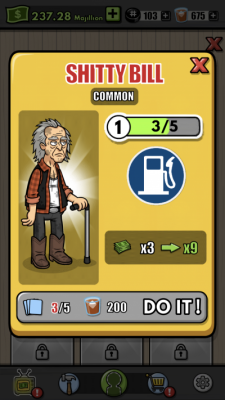
Unfortunately, this made the system completely optional. The player could engage with it and gain marginal benefits or ignore it and progress almost as quickly. A major turning point in the design came when we decided to require certain character levels to automate businesses. Automation is a critical part of any idle game design, and forcing players to interact with the gacha system to use automation meant that every single player would be chasing cards and Liquor to be able to advance. This had a huge impact on the game’s monetization, which is much higher than most other idle games.
The Trouble With Ascension
Ascension systems are core to idle game design. After the player has played for a while, their progress slows down a crawl because of the structure of the underlying math. The player then decides to restart the game (often called ascending, prestiging, restarting, or a variety of other names). When they restart, they earn a special currency that tweaks the game math in some way, generally allowing them to progress faster.
This well-worn system has a number of issues. Deciding when to ascend can be very awkward for casual players, as it requires a good understanding of the game’s math and ascension system. And ascension currencies tend to be a bit abstract and weird. And the story behind why the player is restarting the game from the beginning is thin or altogether missing.
In TPB, our season and gacha systems solved major problems with the ascension system. Because the player cannot ascend until they complete enough goals, the game gives them a clear signal on when they should ascend. Of course some of our more engaged players play on long after we let them move on to the next season, but at least our most casual players don’t have to sweat the decision.
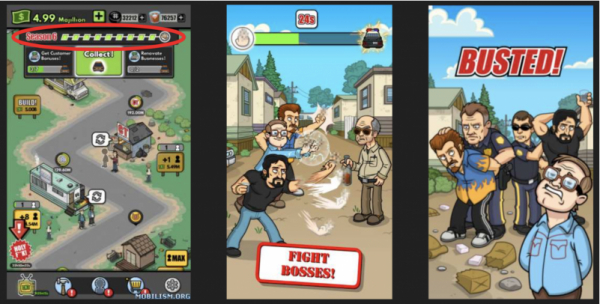
Likewise, rather than having an ascension currency, we simply carry the player’s character and business levels forward. Since the player has built up those bonuses during gameplay, it’s only natural that those levels should be maintained and carried forward.
And the story of ascension fits the license like a glove. On the TV show, the boys are constantly getting thrown into jail for one reason or another, usually for their ridiculous scams and petty crimes. In Trailer Park Boys: Greasy Money, we used that trope from the show to explain our ascension mechanic. When the player resets the game, it’s because the boys lost their fight with the police and got thrown in jail once again. And with the boys gone, their business empire falls apart and needs to be rebuilt. This perfect alignment of mechanic and narrative has been one of the most beloved features of the game.
Content Challenges
Although all these design elements helped make the game into a success, they all created significant challenges on the design and production side – each in their own special way.
The stories themselves are a central element of the design, and they were surprisingly hard to get right. The TV show’s stories have a very particular flavor, and getting the humor, pacing, and character relationships in good shape required many iterations. In addition to going through a number of contract writers looking for folks who really got the IP, the team put in many nights and weekends working to get the narrative on point. But because we knew that the game’s core audience would be super-fans of the show, it was critical that we kept going until we got it right.
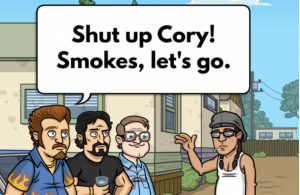
The use of goals and seasons made the gameplay sing, but that came at a price. Instead of just needing to create a fun progression with inflection points for each business, we needed to carefully hand-craft a set of goals that could be completed at exactly the right cadence to keep the player engaged while dragging just enough to create real incentives for monetization. This is an incredibly ticklish balance that requires significant playtesting and iteration for every single season, and we sometimes get it wrong. We are constantly looking at player data and re-adjusting existing seasons.
The gacha system added great monetization, but also added a lot of randomness to the player’s state. It would be very possible for two players who have progressed equally quickly to suddenly diverge over the course of a season because one had the right characters upgraded for that season while the other did not. This meant that accurately forecasting how long players would take to complete seasons and goals was very trickyand our estimates were often off by a good bit.
We also did very well at engaging players with the character upgrade gacha system, but never found the right mechanic to generate similar levels of engagement with building upgrades. We had a few ideas, but none of them have made their way into the game yet.
Final Outcomes
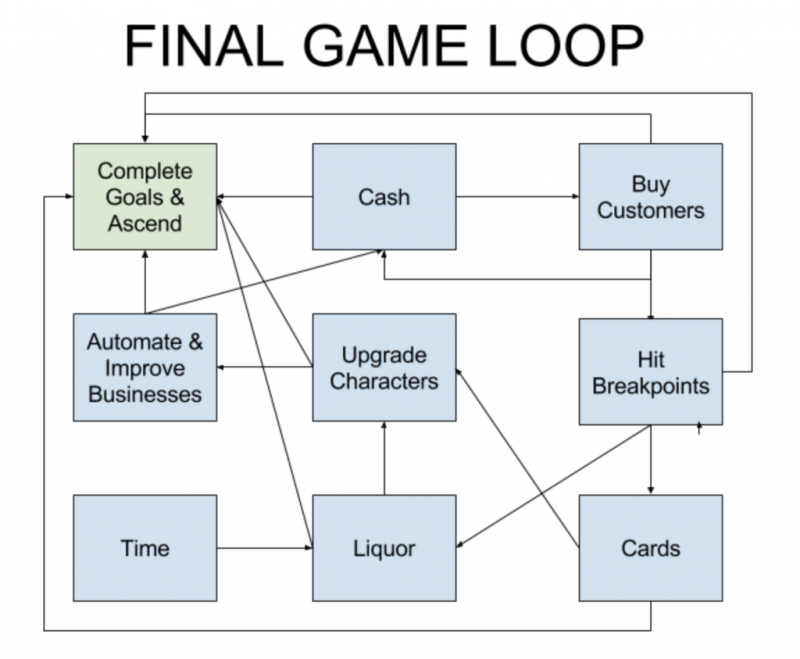
Trailer Park Boys: Greasy Money release on April 20th (4/20 – get it?) and shot up the download and grossing charts. It set records for daily gross revenues for a mobile idle game and drew rave reviews from critics and users (still over 4.5 stars on the Apple and Google app stores). Now nearly six months old, the game continues to generate great revenue and goodwill as we continue to roll out linear content, new events, new features, and new platforms.
There were a number of critical design decisions that contributed to this success, but in my view the three most critical were:
- Gacha: Building a strong gacha system and baking it firmly into the game’s core loop helped the game monetize far better than competitors and opened up interesting new vectors of gameplay.
- Celebrating the IP: Letting theTrailer Park Boys IP guide chunks of the gameplay, and not just the game’s presentation, led us to fun, novel places, and guaranteed the game would be a hit with the show’s fans.
- Challenging genre conventions: We were not afraid to challenge some entrenched idle game design tropes, like leaving the ascension decision entirely to the player or avoiding linear content. Our willingness to break these rules let us build something that was not just unique but also fun and fresh for players, and high performing for East Side Games.
About the Author
Dave Rohrl es el propietario de Mobile Game Doctor , una consultora boutique de diseño de juegos que trabaja con desarrolladores de juegos de todo el mundo para mejorar sus juegos, equipos y procesos. Dave es un veterano de la industria con casi 25 años de experiencia que ha ocupado puestos directivos en Pogo, PopCap y Playdom, entre otros. Vive en el Área de la Bahía de San Francisco con sus dos hijas y 600 juegos de mesa.
Leave a Reply